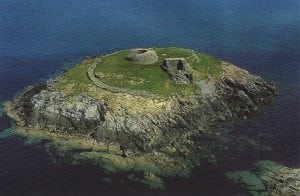- Created: October 15, 2013 2:34 pm
- Updated: December 12, 2017 10:59 am
- Distance Instructions
- Distance 0 m
- Time 0 s
- Speed 0.0 km/h
- Min altitude 0 m
- Peak 0 m
- Climb 0 m
- Descent 0 m
Church Island in Valentia Harbour, Co Kerry in the southwest of Ireland became home to an important early medieval ecclesiastical site in the 7th century but before time, was a centre for fuel for iron smelting. This tiny island had a little monastery, with oratory, hut, holy well and shrine. During excavations, the traces of an earlier wooden oratory were also found.
Ask someone in Knightstown about getting a ferry to view the Island and you could also hire Kayaks and paddle around it.
Alan E Hayden, the director of more than 200 medieval excavations in Ireland, believes the grouping of islands off the Kerry coast suggests earthquake and tsunami wave style damage. Hayden cross-checked folk tales with archaeological and geological evidence and said the grouping of Valentia, Beginish and Church islands may ‘bear the scars of earthquakes and tsunami-type waves in medieval times’. Hayden also suggests that there are indications that Church Island may have been connected to nearby Beginish Island but that the wave led to erosion of the connecting land. A sand bar still partly connects the two islands.
A folk tale collected by a teacher in the early part of the last century (19th) offers an explanation for local place names connected to a road that ran from Dolus Head through the islands to Skellig. The ancient road, a pre-medieval structure, is called Bóthar na Scairte, or road of the cataclysm, and it is traceable for some distance on Valentia. In the folk tale the road and a local hero were destroyed by a great cataclysm, probably an earthquake followed by a wave. According to the tale, ‘a terrible wave 50ft high’ rushed towards a gathering of people on a summer day on Valentia. Everyone except the hero scrambled to higher ground. The wave separated Skellig and Valentia from each other.
Hayden says that the occurrence of tsunamis affecting the south and west coasts of Ireland is surprisingly well documented. A 1775 earthquake in the Portuguese capital Lisbon caused a tsunami which reached Kinsale and which flooded the Spanish Arch in Galway.
The nearby Beginish Island is also a treasure trove of archaeological remains. A ruined monastery can be found on the eastern part of the island and circular stone huts and buildings on the island are remnants of a once vibrant maritime and religious community dating back to the Middle Ages. On the southwest-facing beach on the eastern end of Beginish is a group of eight houses, 15 cairns, and eight animal shelters, occupied between the 10th and 12th centuries, houses which appear to manifest evidence of early Norse/Viking occupation of Ireland. The earliest occupation of the site appears to represent a Scandinavian marine way-station, dated to the 10th century. Valentia, Beginish and Church Islands are simply gems in this most interesting of areas in Ireland.
Church Island in Valentia Harbour, Co Kerry in the southwest of Ireland became home to an important early medieval ecclesiastical site in the 7th century but before time, was a centre for fuel for iron smelting. This tiny island had a little monastery, with oratory, hut, holy well and shrine. During excavations, the traces of an earlier wooden oratory were also found.
Ask someone in Knightstown about getting a ferry to view the Island and you could also hire Kayaks and paddle around it.
Alan E Hayden, the director of more than 200 medieval excavations in Ireland, believes the grouping of islands off the Kerry coast suggests earthquake and tsunami wave style damage. Hayden cross-checked folk tales with archaeological and geological evidence and said the grouping of Valentia, Beginish and Church islands may ‘bear the scars of earthquakes and tsunami-type waves in medieval times’. Hayden also suggests that there are indications that Church Island may have been connected to nearby Beginish Island but that the wave led to erosion of the connecting land. A sand bar still partly connects the two islands.
A folk tale collected by a teacher in the early part of the last century (19th) offers an explanation for local place names connected to a road that ran from Dolus Head through the islands to Skellig. The ancient road, a pre-medieval structure, is called Bóthar na Scairte, or road of the cataclysm, and it is traceable for some distance on Valentia. In the folk tale the road and a local hero were destroyed by a great cataclysm, probably an earthquake followed by a wave. According to the tale, ‘a terrible wave 50ft high’ rushed towards a gathering of people on a summer day on Valentia. Everyone except the hero scrambled to higher ground. The wave separated Skellig and Valentia from each other.
Hayden says that the occurrence of tsunamis affecting the south and west coasts of Ireland is surprisingly well documented. A 1775 earthquake in the Portuguese capital Lisbon caused a tsunami which reached Kinsale and which flooded the Spanish Arch in Galway.
The nearby Beginish Island is also a treasure trove of archaeological remains. A ruined monastery can be found on the eastern part of the island and circular stone huts and buildings on the island are remnants of a once vibrant maritime and religious community dating back to the Middle Ages. On the southwest-facing beach on the eastern end of Beginish is a group of eight houses, 15 cairns, and eight animal shelters, occupied between the 10th and 12th centuries, houses which appear to manifest evidence of early Norse/Viking occupation of Ireland. The earliest occupation of the site appears to represent a Scandinavian marine way-station, dated to the 10th century. Valentia, Beginish and Church Islands are simply gems in this most interesting of areas in Ireland.


